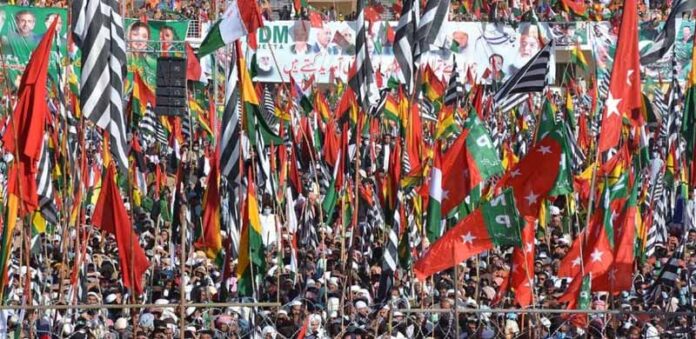The PML-N and the PTI will probably not conduct an in-depth analysis of Sunday’s by-election results, because they will go into an election for the Punjab CM, with the PTI nominee, Ch Parvez Elahi, now likely to win. So many by-elections were conducted that it was arguably a snapshot of general election results, and certainly an in-depth opinion poll.
The result also confounded an apparent media consensus that the PML(N) would win big. With hindsight, that seems based on the fact that the provincial governments have traditionally been able to manage ‘positive results’.
Perhaps most worrisome for the PML(N) is that the seats it lost had included a majority where the PTI had also lost in the general election, to an independent. That independent had joined the PTI, but had believed that this would save them from being unseated if they voted against the party whip in the CM’s election.
However, this by-election, though vital, is something of a sideshow. The real issue is whether there are elections in time for the next government to appoint the next COAS. To allow this, elections must be held by around October 30. That date would require a dissolution by around this time.
In a way, the PML(N)’s acceptance of the results was not just a formality, for the PTI had made it clear it would not accept a defeat. It had made so much noise about rigging, down to naming a ’Mr X’ as responsible for the rigging operation, a thinly veiled reference to a local agency commander.
The PI has done very well and can claim that the electorate has bought into its narrative. The PTI has actually won in eight of the nine constituencies where independents had won, defeating PTI candidates, in the 2018 general election.
One of the murkier factors was how incumbency played out. The outgoing MPA was defeated in 17 constituencies (only one won; two had not contested), indicating that incumbents would be turfed out. But whose incumbency? It could be argued with equal validity that people voted against the MPA’s previous performance during the PTI government, against the party which had given tickets, the PML(N), or simply that the electorate had decided to punish the most salient feature of their tenure, their vote for Hamza.
A casualty has been the power of the government. There does not seem to have been an incumbency advantage. In that respect, the big winner seems to be the Election Commission of Pakistan, which got the by-elections held without any visible interference. This time around, there were no suspicious disappearances of presiding officers, while the local administration has not been accused of any wrongdoing anywhere.
Along with the government, the agencies are a big loser in terms of their reputations as influencers. Much of their power was because politicians accepted their ability to get them victory, which was why some accepted their desires about which party to support. Pre-election rigging was carried out at the microlevel by these means, particularly where there were close fights.
Where the fight was one-sided, agencies would have to offer other inducements for support, such as inclusion in Cabinets. However, one of the things highlighted by the current by-elections is the increase in the size of constituencies, which means that the concept of a narrow margin has changed, and with it the ability of any outside force, such as an agency, to influence the results.
The PTI has either got to treat the results as proof that victory without the agencies is possible, or that the agencies are back on its side. It will suit it to claim that it has won back the support it had lost. While the PTI leadership (and the agencies) only know the truth, the party base will have to be convinced that there is life after dismissal.
It was ironic that the Supreme Court had issued the detailed judgement in the case of the National Assembly Deputy Speaker’s ruling before the by-election, in which it had firmly rejected the existence of a foreign conspiracy to remove the PTI government. However, the electorate in the by-election constituencies bought into that narrative, of a US conspiracy.
It should be remembered that such a narrative resonates with people. Anyone rebelling against this would gain support, not just because of the narrative, but because it provides an explanation of, in the Shakespearean phrase, ‘why we are underlings.’ The readiness to even express it was bound to be popular, not to forget the snook that was cooked at both the military and the judiciary, which hitherto have been not only invincible, but also beyond criticism. It would be going too far to see this as an anti-establishment vote, particularly since the party getting the vote wants the establishment on its side.
By-elections have previously been fought on local issues. True, local issues matter in single-member constituencies, particularly where candidates revise party loyalties from election to election. While impossible to eliminate entirely, party narratives are de-emphasized by candidates who were members of the party not too long ago, and who have jumped ship to another. The candidate has to radically revise his positions, but so do his followers. Thus, for them, the candidate’s espousal of a party is evaluated according to whether that party will form the government, and whether their man will become a minister or not, with the accruing benefits (usually monetary). Thus, it becomes of more importance whether a candidate visited to condole a death, than what party he belongs to.
However, these by-elections were fought on more political lines. The PML(N) will probably do more soul-searching than the PTI, but the big question is how to fight the general election. It has become clear that Maryam Nawaz was not able to spearhead the campaign, and the pressure will build for Mian Nawaz himself to return, and that too able to campaign. Indeed, that might be the sole object of retaining the federal government.
Another thing that has happened because of the result, is that early elections have become that much more likely. Things are up in the air. Getting the Punjab government is an objective of the PTI, but considering how the government has been exposed as toothless, is there any point? How much will he be able to do in the remaining 13 months of the tenure? It perhaps should not be forgotten that Ch Parvez’s first tenure as CM ended with a comfortable PML(N) victory. Of course, if national elections take place without the Punjab dissolving Ch Pervez might be able to give ‘’positive results’.
However, the forces that the PTI is trying to convince might feel that early elections should be held. Will those elections be held early enough to let the new government appoint the next COAS? Though the Punjab government does not make that appointment, the effect of the Punjab being in the hands of the opposition is perhaps too volatile to rate speculation.
However, this by-election, though vital, is something of a sideshow.
The real issue is whether there are elections in time for the next government to appoint the next COAS. To allow this, elections must be held by around October 30. That date would require a dissolution by around this time. Any later dissolution would leave he caretaker government to make the appointment, though it could extend the incumbent’s tenure so that the elected government could make the appointment. These b y-elections make such a dissolution more likely.























